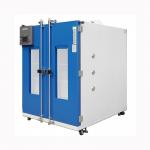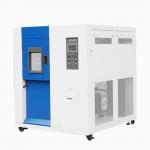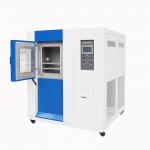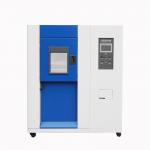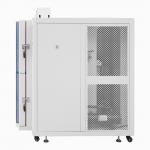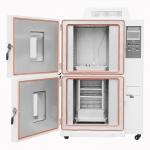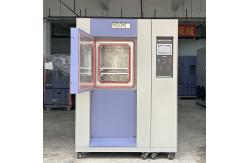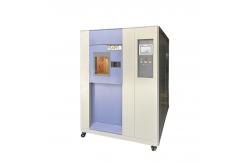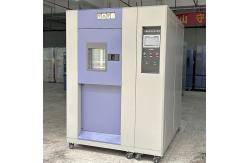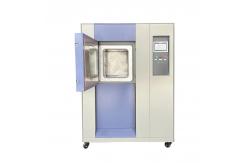In the realm of machinery manufacturing, compliance with the
2006/42/EC test standard is of utmost importance. The Custom
Thermal Shock Chambers designed specifically for this standard
emerge as a crucial tool in ensuring the reliability and safety of
machinery components. This custom-built thermal shock chamber is dedicated to subjecting
machinery components to the rigorous testing requirements of the
2006/42/EC standard. It serves machinery manufacturers, research
institutions, and quality control laboratories. The primary
objective is to evaluate the ability of components such as gears,
bearings, shafts, and housings to withstand rapid and extreme
temperature changes. By simulating the thermal shock conditions
that these components may encounter during their operational
lifespan, manufacturers can identify potential weaknesses, optimize
material selection and manufacturing processes, and enhance the
overall durability and performance of their machinery. - Robust and Insulated Chamber Construction
- The chamber is constructed with heavy-duty, heat-resistant
materials that can endure the intense thermal stresses. The walls
are made of high-strength steel with advanced insulation layers to
minimize heat transfer between the different temperature zones. The
door is equipped with a reliable sealing mechanism and a viewing
window, allowing operators to monitor the testing process without
compromising the integrity of the chamber. The interior is designed
with a unique configuration to create distinct hot and cold zones,
ensuring rapid and uniform temperature transitions.
- Precision Temperature Control System
- Temperature Range and Transition: Capable of achieving a wide
temperature range, typically from -60°C to +180°C. The system can
rapidly switch between the hot and cold zones, with a transition
time as short as a few minutes. This is essential for replicating
the sudden temperature changes that machinery components may
experience, such as when a machine is started in a cold environment
and quickly reaches operating temperature or when it is exposed to
external heat sources during operation. The temperature control is
accurate to within ±0.5°C, ensuring reliable and repeatable test
results.
- Intuitive Control Panel and Data Acquisition Interface
- The control panel is user-friendly and enables operators to easily
set and adjust test parameters such as temperature levels, dwell
times in each zone, and the number of thermal shock cycles. It
provides real-time displays of the current temperature in both
zones, the status of the testing process, and any alarms or
warnings. The chamber is integrated with a comprehensive data
acquisition system that records all relevant test data. This
includes temperature histories, cycle times, and any observable
changes in the physical or mechanical properties of the components.
The data can be stored in a built-in memory or exported to external
storage devices for further analysis. The system can also generate
detailed test reports in various formats.
- Safety Features and Alarms
- Over-temperature and over-current protection are crucial safety
features, ensuring that the chamber and the test samples are not
damaged in case of a temperature control malfunction. Emergency
stop buttons are strategically placed for immediate shutdown if
required. Alarms are triggered for abnormal temperature
fluctuations, equipment failures, or any other safety-related
issues. The chamber is also equipped with proper ventilation and
exhaust systems to handle any potentially harmful gases or vapors
that may be generated during the testing process.
- Temperature Range and Accuracy
- The -60°C to +180°C temperature range with ±0.5°C accuracy provides
a comprehensive testing spectrum. Different machinery components
may have different temperature tolerances and material properties.
For example, metal alloys used in high-temperature applications
need to maintain their strength and integrity at elevated
temperatures, while polymers used in certain components may become
brittle at low temperatures. The accurate temperature control
ensures that the test conditions are precisely maintained, allowing
for a detailed assessment of component performance.
- Thermal Shock Cycle Parameters
- The chamber can be programmed to perform a specific number of
thermal shock cycles, typically ranging from 10 to 1000 or more,
depending on the requirements of the 2006/42/EC standard and the
nature of the components. The dwell time in each temperature zone
can also be adjusted, from a few minutes to several hours. This
flexibility allows manufacturers to simulate a wide variety of
real-world scenarios and evaluate the long-term durability of
components under different thermal shock conditions.
- Testing Volume and Payload Capacity
- The chamber offers a customizable testing volume, usually ranging
from 2 m³ to 10 m³, to accommodate a significant number of
machinery components. The payload capacity is designed to handle
heavy and bulky parts, with a maximum capacity of up to several
tons. This enables efficient testing of both individual components
and small assemblies.
- Data Sampling Frequency and Resolution
- The data acquisition system samples data at a frequency of up to
500 Hz. The temperature data has a resolution of 0.1°C. This
high-resolution and frequent sampling enable the detection of even
the slightest temperature changes and trends, providing valuable
insights into the behavior of the machinery components during
thermal shock testing.
- Accurate Simulation of 2006/42/EC Test Conditions
- The chamber replicates the exact thermal shock conditions specified
in the 2006/42/EC standard. This is crucial as machinery components
must meet these requirements to ensure their compliance and safety.
By subjecting the components to these precise simulations,
manufacturers can be confident that their products will perform as
expected in real-world applications.
|
